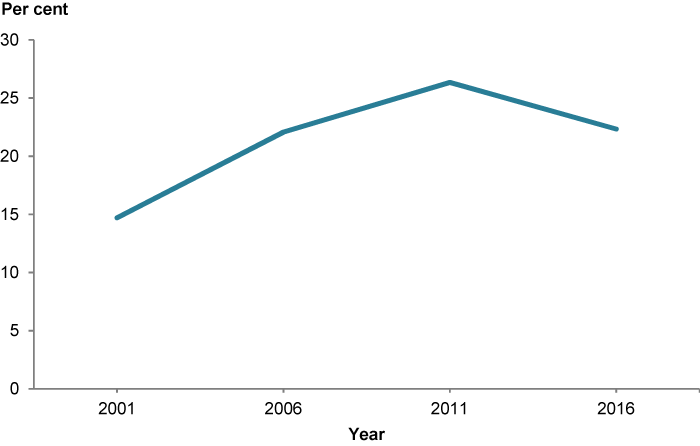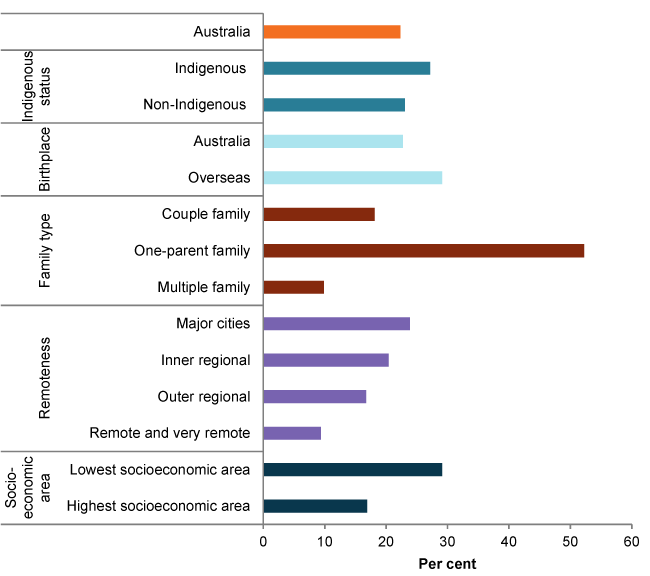Housing stress
Key findings
- In 2016, more than one-fifth of children aged 0–14 lived in households experiencing housing stress.
- More than half (52%) of children in 1-parent households were living under housing stress.
- Housing stress decreased with remoteness—ranging from 24% of households in Major cities to 9% in Remote and very remote areas.
The housing conditions in which people live and the security of those living arrangements can influence a person or family’s health and wellbeing (McLachlan et al. 2013). Housing costs, such as rent payments, rate payments, or mortgages, are often the largest regular expense in a household’s budget and a household’s capacity to cover these costs varies according to family economic situation.
Secure housing gives people a sense of autonomy, certainty and control that can lead to lower levels of stress and greater family stability (Taylor & Edwards 2012). Children in households that can afford adequate housing often have better health and school engagement (Clair 2018). In contrast, high housing costs can cause housing stress. This stress and resulting financial hardship can:
- affect parental mental health
- reduce investment in children’s food, health and education
- increase a child’s risk of material deprivation and social exclusion (Robinson & Adams 2008; Taylor & Edwards 2012; Yates et al. 2007).
This section looks at the number of children aged 0–14 living with financial stress due to high housing costs.
Box 1: Data source and definitions
Data on housing stress are taken from the ABS Census of Population and Housing. The Census collects information on welfare-related topics, including housing and income. It is administered by the ABS every 5 years, with the latest data available for 2016.
How is housing stress defined?
In general terms, housing stress is experienced when housing costs are high relative to income (ABS 2019). In these situations, high housing costs are likely to cause financial stress and reduce the household’s ability to afford other living costs such as food, clothing, transport and utilities (Rowley & Ong 2012).
Housing stress can be defined in many ways, but for this section, households are considered to be under housing stress if more than 30% of gross household income is spent on housing costs. This definition—which includes all households with children aged 0–14 years regardless of income level—is broader than housing stress measures limited to low-income households (AHURI 2019). This approach is consistent with data reported against the Children’s Headline Indicators.
For more information on different methodologies, see Data limitations and development opportunities below.
How many children live in households experiencing housing stress?
In 2016, more than one-fifth (22% or around 975,000) of children aged 0–14 lived in households experiencing housing stress.
- Boys and girls were equally as likely to live in households experiencing housing stress (both 22%).
- Younger children aged 0–4 were slightly more likely than older children aged 5–14 to live in households experiencing housing stress (23% compared with 22%).
Have rates of housing stress changed over time?
The proportion of children aged 0–14 living in households experiencing household stress increased from 15% in 2001 to 26% in 2011, before dropping slightly to 22% in 2016 (Figure 1).
Figure 1: Proportion of children aged 0–14 living in households experiencing housing stress, 2001–2016

Chart: AIHW. Source: Census data.
Are rates of housing stress the same for everyone?
Children born overseas were more likely than children born in Australia to live in households experiencing housing stress (29% compared with 23%, respectively). More than half of children from 1-parent families were living in households with housing stress (52%). This was nearly 3 times the proportion of children from couple families (18%) and more than 5 times the proportion of those from households with multiple families (10%).
Children living in Major cities were the most likely to be living in households experiencing housing stress (24%), while children living in Remote and very remote areas were the least likely (9.4%).
Children living in the lowest socioeconomic areas were more likely than children in highest socioeconomic areas to live in households experiencing housing stress (29% compared with 17%). Level of socioeconomic disadvantage is determined by the area a person is living in and not by individual perceptions or responses.
In 2016, the proportion of children aged 0–14 living in households experiencing housing stress was higher among Aboriginal and Torres Strait Islander children (27%) than non-Indigenous children (23%) (Figure 2).
Figure 2: Proportion of children aged 0–14 living in households experiencing housing stress, by priority population group, 2016

Chart: AIHW. Source: ABS Census.
Data limitations and development opportunities
This section looks at children living in households with housing stress, regardless of household income level (low, medium or high).
The burden of high housing costs disproportionately affects households with low incomes. High housing costs can reduce a low-income household’s ability to buy necessities such as food, healthcare or educational resources (Taylor & Edwards 2012; Warren 2018). In comparison, those on higher incomes who pay more than 30% on housing are more likely to do so as a choice, and they can afford to do so without forgoing essential items (AHURI 2019; McLachlan et al. 2013).
Data disaggregated by income groups focusing on low-income households, would provide further insights into the level of housing stress experienced by vulnerable populations. There is scope to review the Children’s Headline Indicator to ensure it reflects contemporary information needs.
The AIHW has published some data on housing stress by tenure and income levels in the Housing affordability snapshot of Australia’s Welfare and the AIHW Housing data dashboard.
For more information on defining housing stress, see Understanding the 30:40 indicator of housing affordability stress.
Where do I go for more information?
For more information about:
- Indigenous children and housing stress, see: Indigenous Children
- housing stress among children aged 0–14, see: Children’s Headline Indicators.
- financial housing stress, see: Housing Assistance in Australia: Financial assistance.
- home ownership and housing tenure, see: Home ownership and housing tenure.
- housing affordability, including housing stress among low-income households—the 30:40 rule (including families), see: Housing affordability.
ABS (Australian Bureau of Statistics) 2018. Census of Population and Housing customised report. ABS cat.no. 2901.0. Canberra: ABS.
ABS 2019. Housing occupancy and costs, 2017–18. ABS cat. no. 4130.0. Canberra: ABS.
AHURI (Australian Housing and Urban Research Institute) 2019. Understanding the 30:40 indicator of housing affordability stress. AHURI Brief. Viewed 23 August 2019.
Clair A 2018. Housing: an under-explored influence on children’s well-being and becoming. Child Indicators Research 12(2):609–626.
McLachlan R, Gilfillan G & Gordon J 2013. Deep and persistent disadvantage in Australia. Productivity Commission staff working paper. Canberra: Productivity Commission.
Robinson E & Adams R 2008. Housing stress and the mental health and wellbeing of families. Australian Family Relationships Clearinghouse briefing no. 12. Melbourne: Australian Institute of Family Studies.
Rowley S & Ong R 2012. Housing affordability, housing stress and household wellbeing in Australia, AHURI Final Report No.192. Melbourne: AHURI.
Taylor M & Edwards B 2012. Housing and children’s wellbeing and development; Evidence from a national longitudinal study. Family Matters no. 91. Melbourne: AIFS.
Warren D 2018. Children’s housing experiences. In D. Warren and G Draganova (Eds.), Growing up in Australia—The Longitudinal Study of Australian Children, Annual Statistical Report 2017. Melbourne: AIFS.
Yates J, Milligan V, Berry M, Burke T, Gabriel M, Phibbs P et al. 2007. Housing affordability: a 21st century problem. National Research Venture 3: Housing Affordability for lower income Australians. Australian Housing and Urban Research Institute. Melbourne: AHURI.


